A Parametric Study of Blast Damage on Hard Rock Pillar Strength
Abstract
:1. Introduction
2. Theoretical Background
- The presence of geology and water;
- A weak roof or floor;
- The effects of blasting;
- The dip.
2.1. Blast Damage Zone Properties
2.2. Effect of Pillar Height
2.3. Effect of Pillar Inclinations
3. Numerical Modeling
3.1. Grid Generation
3.2. Mesh Generation and Loading Rate
3.3. Boundary Conditions
3.4. Material Properties
3.5. Model Calibration
4. Results and Discussion
4.1. Effect of Blast Damage on Pillar Width-to-Height Ratio
4.2. Effect of Blast Damage on Pillar Height
4.3. Effect of Blast Damage on Inclined Pillars
5. Conclusions
Author Contributions
Funding
Conflicts of Interest
References
- Oriad, L.L. Blasting effect and their control. In Underground Mining Methods Handbook; Hustrulid, W., Ed.; AIME: New York, NY, USA, 1982. [Google Scholar]
- Forsyth, W.W.; Moss, A.E. Investigation of Development Blasting Practices; Canmet Mrl: Hamilton, ON, Canada, 1991. [Google Scholar]
- Yu, T.R.; Vongpaisal, S. New blast damage criteria for underground blasting. CIM Bull. 1996, 89, 139–145. [Google Scholar]
- Warneke, J.; Dwyer, J.G.; Orr, T. Use of a 3D scanning laser to quantify dift geometry and overbreak due to blast damage in underground manned entries. In Rock Mechanics: Meeting Society’s Challenges and Demands; Eberhardt, E., Stead, D., Morrison, T., Eds.; Taylor & Francis Group: London, BC, Canada, 2007. [Google Scholar]
- Kutter, H.K.; Fairhurst, C. On the fracture process in blasting. Int. J. Rock Mech. Min. Sci. 1971, 8, 181–202. [Google Scholar] [CrossRef]
- Wilson, W.H.; Holloway, D.C. Fragmentation studies in instrumented concrete models. In Proceedings of the International Congress on Rock Mechanics, Montreal, QC, Canada, 30 August–3 September 1987. [Google Scholar]
- Djordjevic, N. Two-component model of blast fragmentation. In Proceedings of the International Symposium on Rock Fragmentation by Blasting, Johannesburg, South Africa, 8–12 August 1999. [Google Scholar]
- Olsson, M.; Ouchterlony, F. New Formula for Blast Induced Damage in the Remaining Rock; SveBeFo Report No. 65; Swedish Rock Engineering Research: Stockholm, Sweden, 2003. [Google Scholar]
- Fleetwood, K.G. Near-Field Blast Vibration Monitoring and Analysis for Prediction of Blast Damage in Sublevel Open Stoping. Ph.D. Dissertation, Curtin University, Kalgoorlie, WA, USA, 2010. [Google Scholar]
- Ouchterlony, F.; Olsson, M.; Bergqvist, I. Towards new Swedish recommendations for cautious perimeter blasting. Int. J. Blasting Fragmentation 2010, 6, 235–261. [Google Scholar] [CrossRef]
- Hoek, E.; Carranza Toress, C.; Corkum, B. Hoek-Brown failure criterion—2002 edition. In Proceedings of the 5th North American Rock Mechanics Symposium and 17th Tunneling Association of Canada Conference, Toronto, ON, USA, 7–10 July 2002. [Google Scholar]
- Sharifzadeh, M.; Pal, M. Quantification of rock mass disturbance using rock-mass property, rock characterization and blast characterization in underground hard-rock. In Proceedings of the 8th Asian Rock Mechanics Symposium, Sapporo, Japan, 14–16 October 2014. [Google Scholar]
- Torbica, S.; Lapčević, V. Estimating extent and properties of blast-damaged zone around underground excavations. Rev. Esc. Minas 2015, 68, 441–453. [Google Scholar] [CrossRef] [Green Version]
- Shen, B.; Barton, N. Disturbed zone around tunnels in jointed rock masses. Int. J. Rock Mech. Min. Sci. 1997, 34, 117–125. [Google Scholar] [CrossRef]
- Saiang, D. Blast-Induced Damage: A Summary of SveBeFo Investigations; Luleå Tekniska Universitet: Luleå, Sweden, 2008. [Google Scholar]
- Mitelman, A.; Elmo, D. Modelling of blast-induced damage in tunnels using a hybrid finite-discrete numerical approach. Rock Mech. Geotech. Eng. 2014, 6, 565–573. [Google Scholar] [CrossRef]
- Bahrani, N.; Suorineni, F.T.; Kaiser, P.K. Stability Analysis of Rib Pillars in Mechanized and Drill and Blast Excavations Using Numerical Modeling. In Proceedings of the MEMO’2010, Sudbury, ON, Canada, 24–27 October 2010. [Google Scholar]
- Lunder, P.J. Hard Rock Pillar Strength Estimation an Applied Approach. Master’s Thesis, University of British Columbia, Vancouver, BC, Canada, 1994. [Google Scholar]
- Hedley, D.G.F.; Grant, F. Stope and pillar design for the Elliot lake uranium mines. Can. Inst. Min. Metall. Bull. 1972, 65, 37–44. [Google Scholar]
- Potvin, Y.; Hudyma, M.; Miller, H.D.S. Rib pillar de sign in open stoping. Can. Inst. Min. Metall. Bull. 1989, 82, 31–36. [Google Scholar]
- Esterhuizen, G.S.; Dolinar, D.R.; Ellenberger, J.L. Pillar strength and design methodology for stone mines. In Proceedings of the 27th International Conference on Ground Control in Mining, Morgantown, WV, USA, 29–31 July 2008. [Google Scholar]
- Elmo, D.; Stead, D. An integrated numerical modelling—Discrete fracture network approach applied to the characterisation of rock mass strength of naturally fractured pillars. Rock Mech. Rock Eng. 2010, 43, 3–19. [Google Scholar] [CrossRef]
- Hoek, E.; Diederichs, M.S. Empirical estimation of rock mass modulus. Int. J. Rock Mech. Min. Sci. 2006, 43, 203–215. [Google Scholar] [CrossRef]
- Kaiser, P.K.; Kim, B.; Bewick, R.P.; Valley, B. Rock strength and depth and implications for pillar design. In Proceedings of the 5th International Seminar on Deep and High Stress Mining, Santiago, Chile, 6–8 October 2010. [Google Scholar]
- Ayres da Silva, L.A.; Ayres da Silva, A.L.M.; Sansone, E.C. The shape effect and rock mass structural control for mine pillar design. In Proceedings of the ISRM International Symposium, EUROCK, Wroclaw, Poland, 23–26 October 2013. [Google Scholar]
- Suorineni, F.T.; Mgumbwa, J.J.; Kaiser, P.K.; Thibodeau, D. Mining of orebodies under shear loading Part 1—Case histories, Mining Technology. Trans. Inst. Min. Metall. A 2011, 120, 138–147. [Google Scholar]
- Suorineni, F.T.; Mgumbwa, J.J.; Kaiser, P.K.; Thibodeau, D. Mining of orebodies under shear loading Part 2—Failure modes and mechanisms, Mining Technology. Trans. Inst. Min. Metall. A 2014, 123, 240–249. [Google Scholar]
- Itasca Consulting Group. Fast Lagrangian Analysis of Continua in 3Dimensions; Itasca Consulting Group: Minneapolis, MN, USA, 2016. [Google Scholar]
- Esterhuizen, G.S. An evaluation of the strength of slender pillars. Trans. Soc. Min. Metall. Explor. Inc. 2006, 320, 69–76. [Google Scholar]
- Lu, J.; Ray, A.; Morsey, K.; Peng, S. Effects of rock/coal interface property on coal pillar strength. In Proceedings of the 27th International Conference on Ground Control in Mining, Morgantown, WV, USA, 29–31 July 2008. [Google Scholar]
- Perry, K.A.; Unrug, K.F.; Harris, K.W.; Raffaldi, M.J. Influence of roof/floor interface on coal pillar performance. In Proceedings of the 32nd International Conference on Ground Control in Mining, Morgantown, WV, USA, 30 July–1 August 2013. [Google Scholar]
- Martin, C.D.; Kaiser, P.K.; McCreath, D.R. Hoek–Brown parameters for predicting the depth of brittle failure around tunnels. Can. Geotech. J. 1999, 36, 136–151. [Google Scholar] [CrossRef]
- Kaiser, P.K.; Diederichs, M.S.; Martin, C.D.; Sharp, J.; Steiner, W. Underground works in hard rock tunnelling and mining. In Proceedings of the GeoEng2000, Melbourne, Australia, 19–24 November 2000. [Google Scholar]
- Roux, A.J.A.; Leeman, E.R.; Denkhaus, H.G. Destressing: A Means of Ameliorating Rockburst Conditions. Part I: The Concept of Destressing and Results Obtained from Its Application. J. S. Afr. Inst. Min. Metall. 1958, 59, 66–68. [Google Scholar]
- Salamon, M.G.D. Rockburst hazard and the fight for its alleviation in South African gold mines. In Rockbursts: Prediction and Control; IMM: London, UK, 1983. [Google Scholar]
- Andrieux, P.P.; Brummer, R.K.; Liu, Q.; Simser, B.P.; Mortazavi, A. Large scale panel destress blast at Brunswick mine. J. Can. Inst. Min. Metall. Pet. 2003, 96, 78–87. [Google Scholar]
- Krauland, N.; Söder, P.E. Rock Stabilisation by Destress Blasting Experiences from Boldien Mines, Rock Mechanics Meeting; BeFo: Stockholm, Sweden, 1988. [Google Scholar]

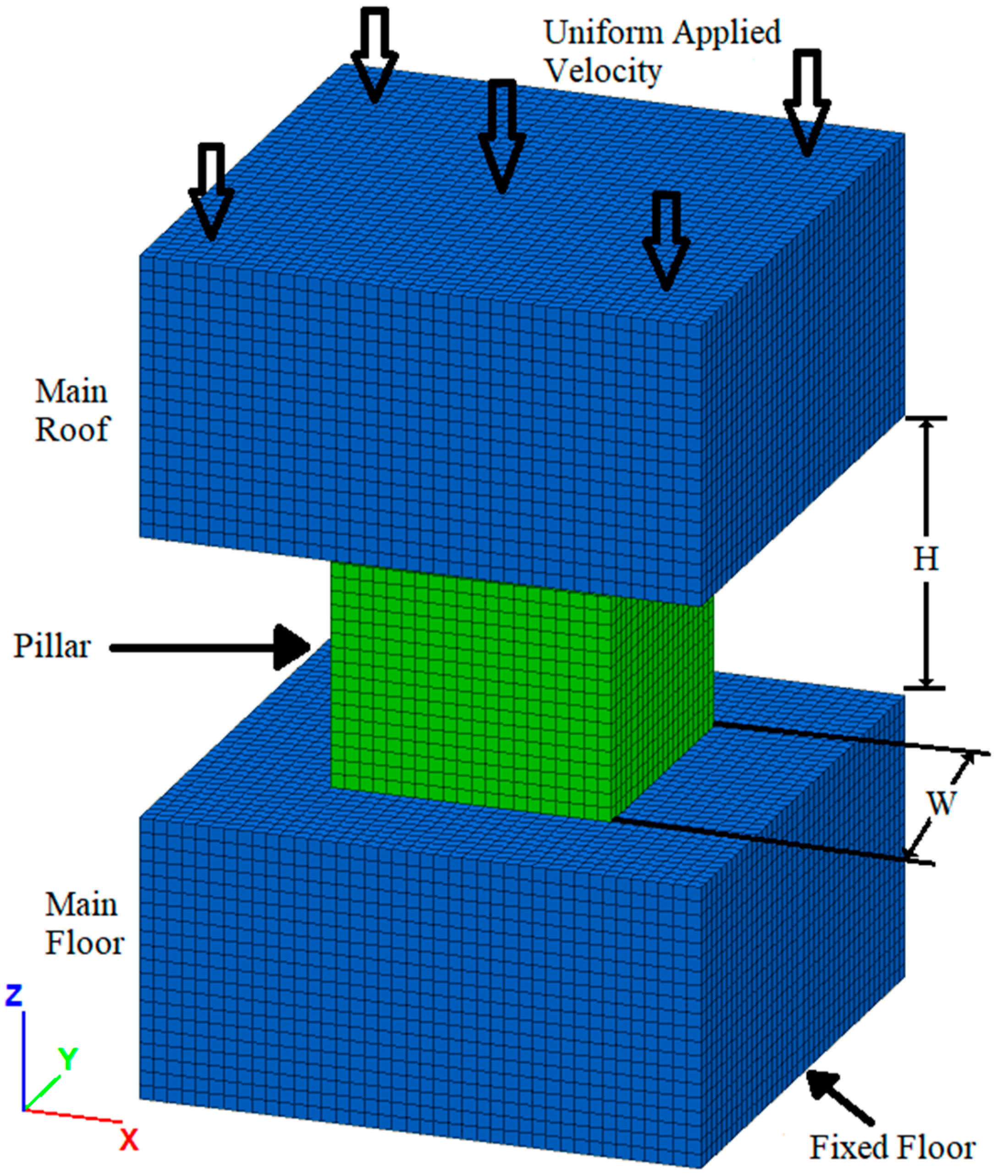
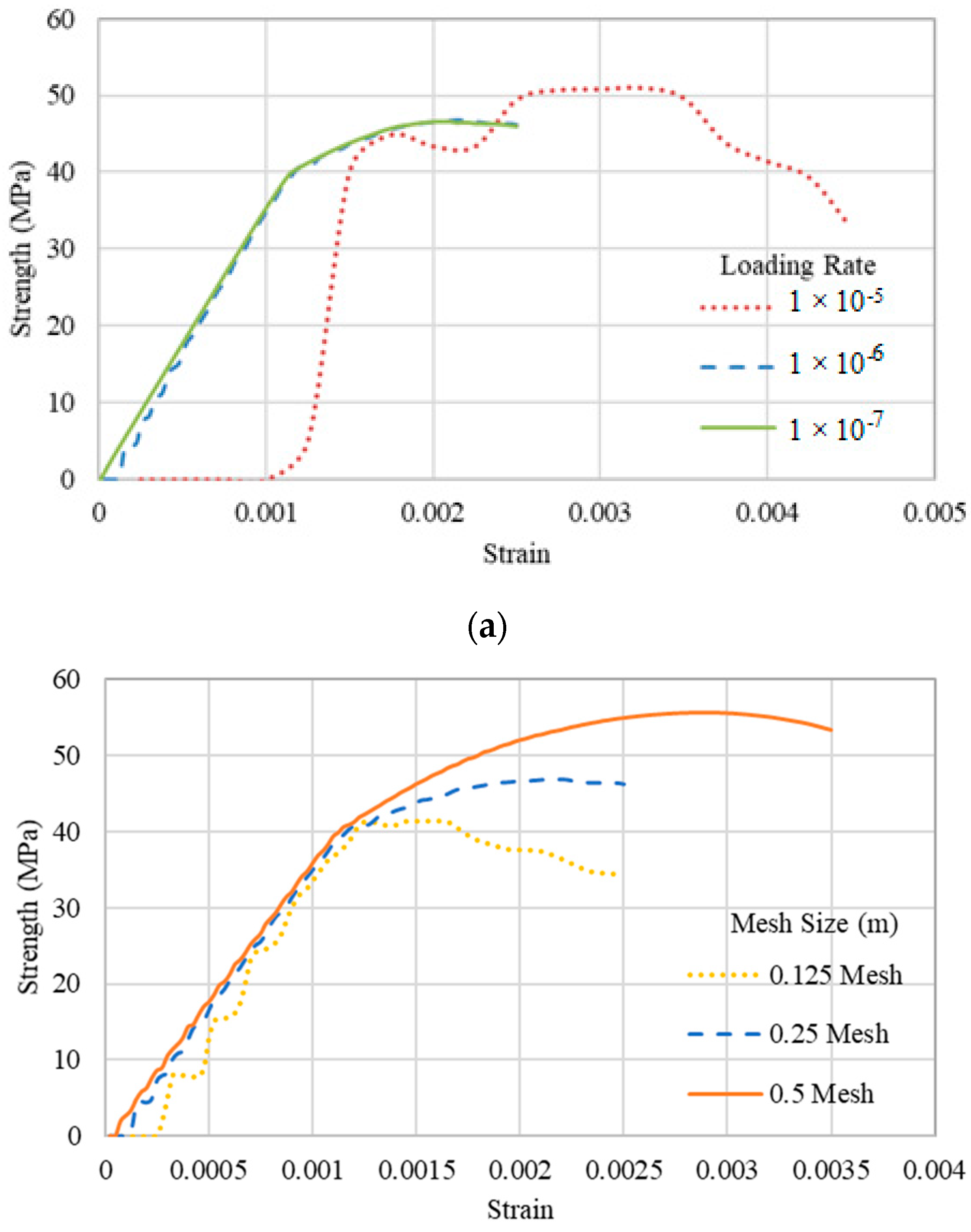


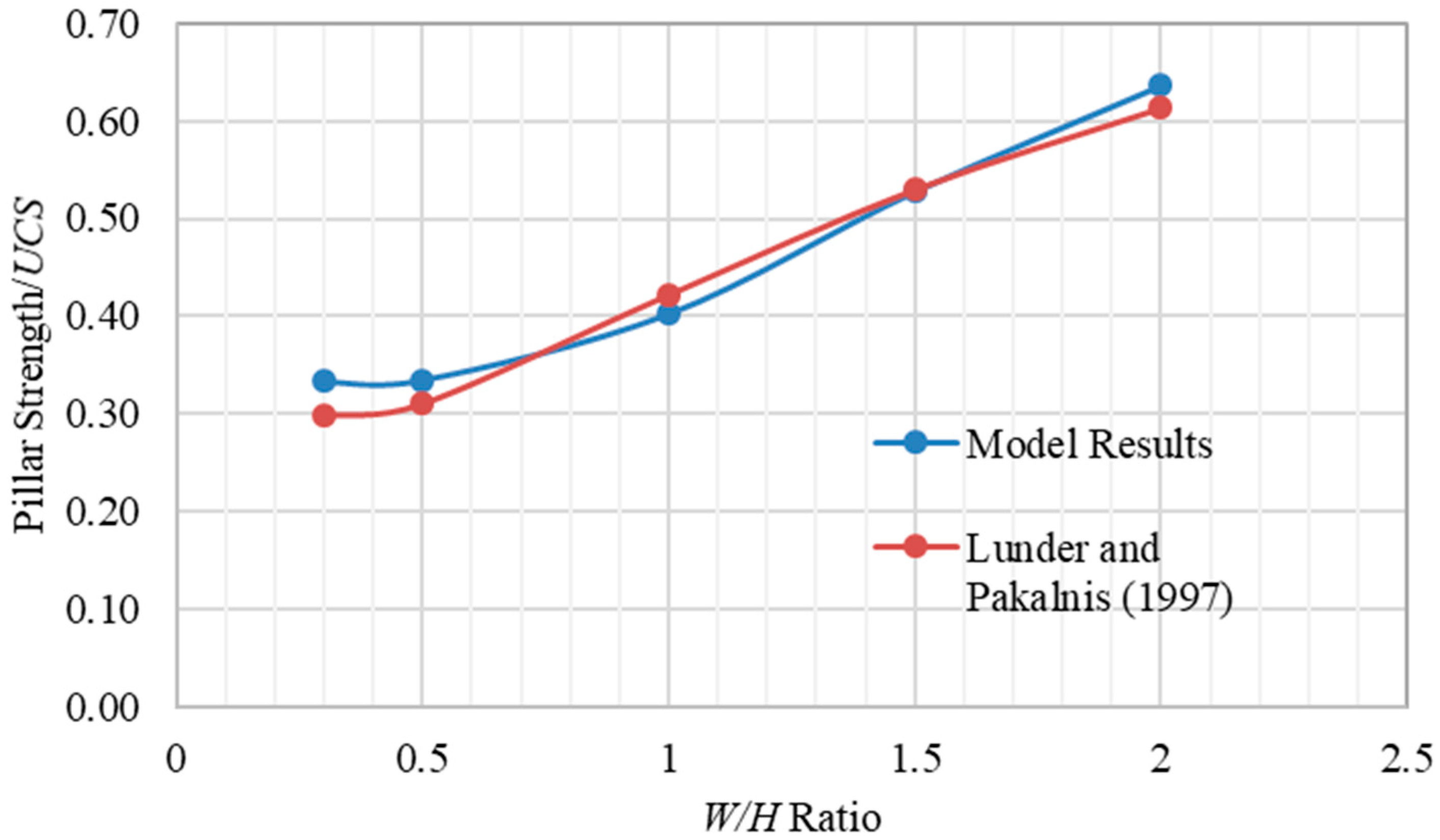

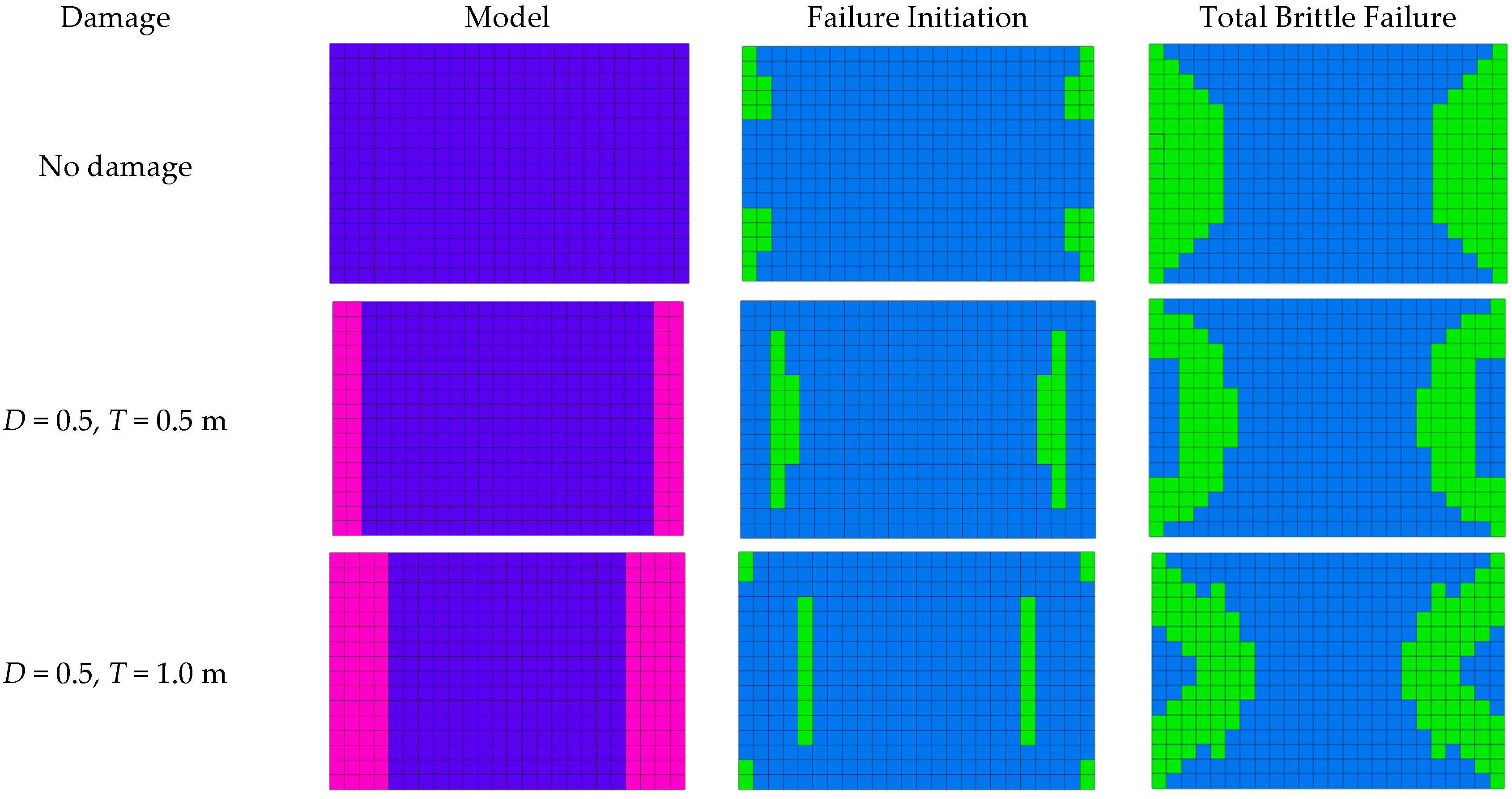

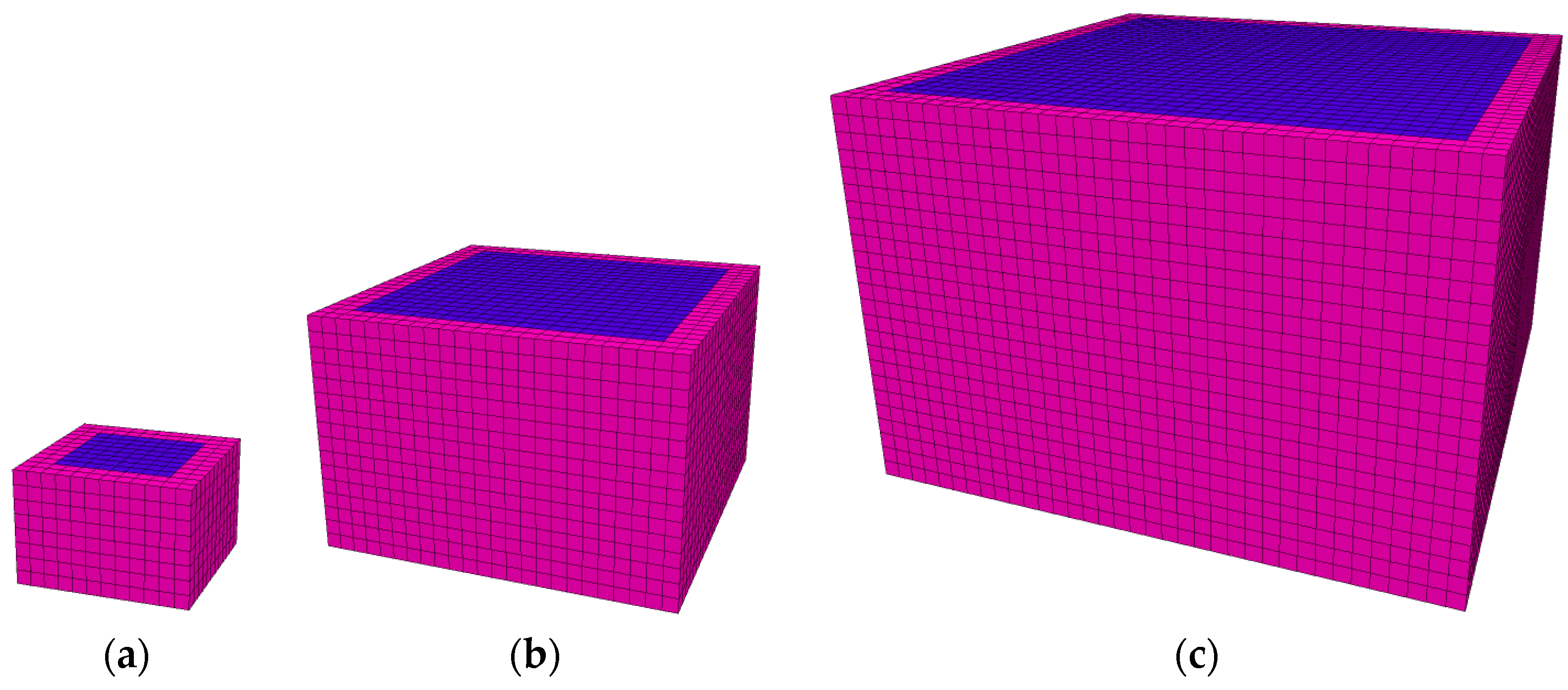
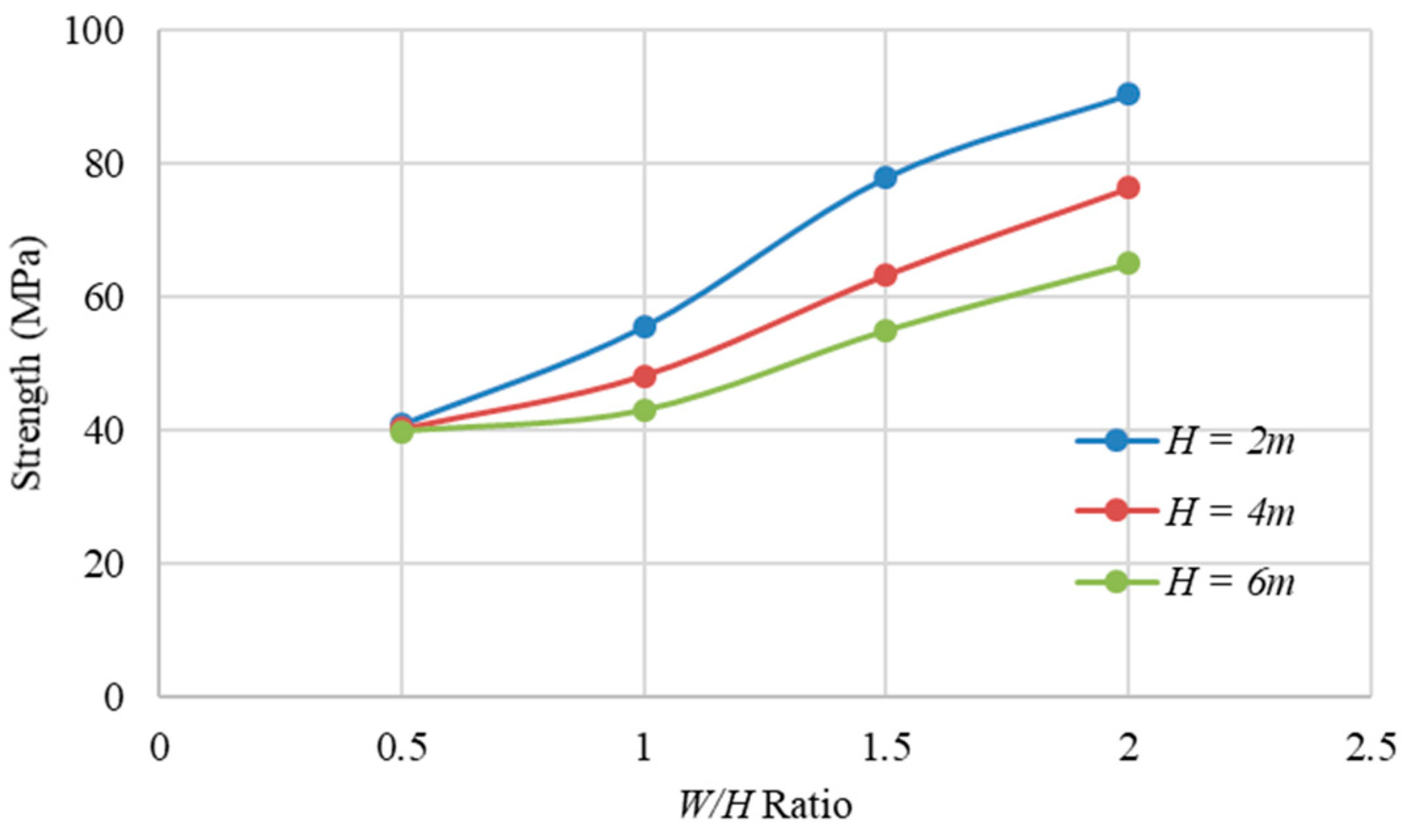
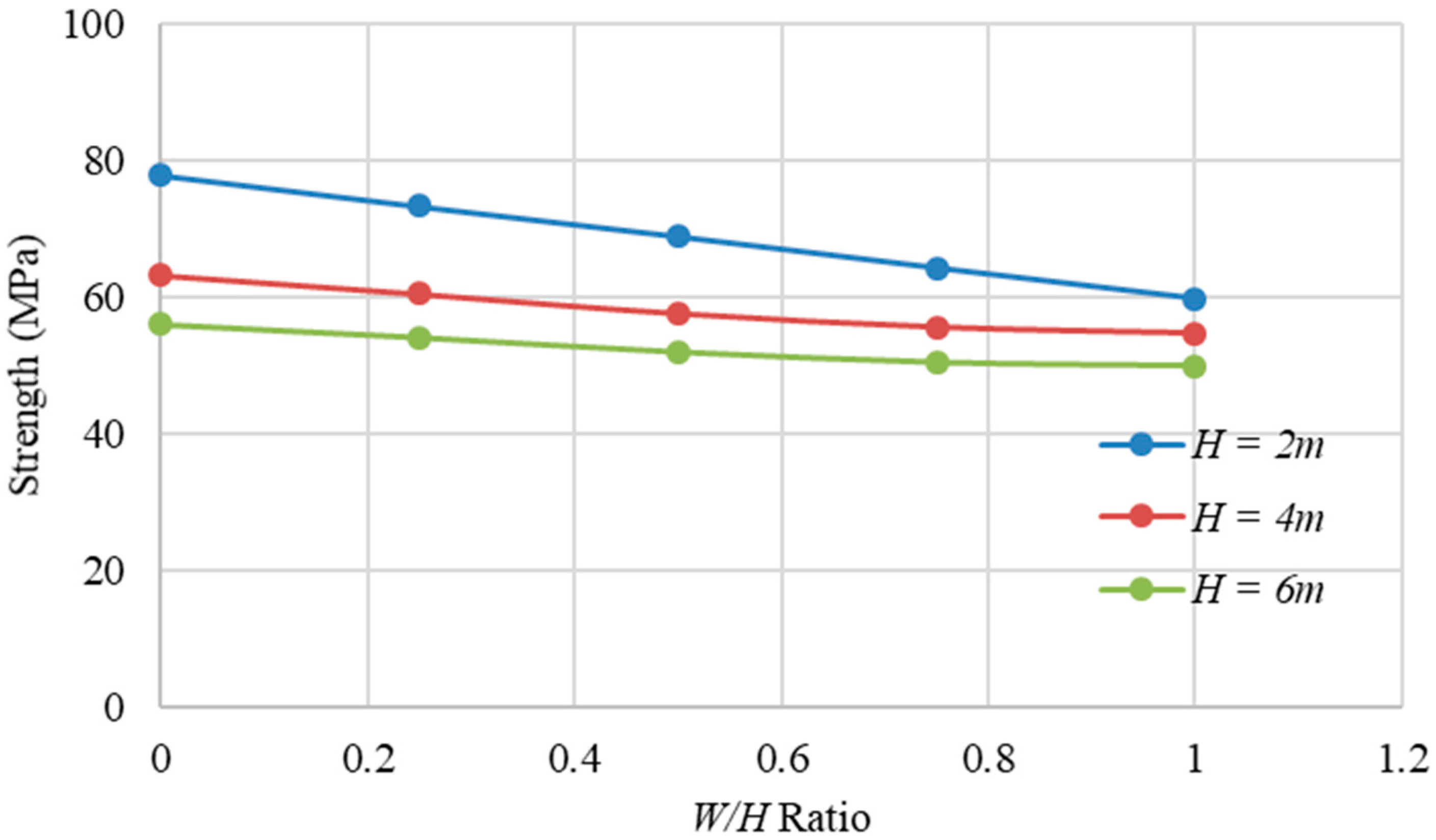


| Loading Rate (m/Step) | Model Run Time (Min.) |
|---|---|
| 1 × 10−5 | 1 |
| 1 × 10−6 | 4 |
| 1 × 10−7 | 34 |
| Rock Mass Properties | Numerical Value |
|---|---|
| Young’s Modulus | 70 GPa |
| Cohesion (Brittle) | 20 MPa |
| Friction (Brittle) | 0 |
| Cohesion (Mohr-Coulomb) | 6.5 MPa |
| Friction (Mohr-Coulomb) | 42.7 |
| Tensile Strength | 7 MPa |
| Dilation | 30 |
| Joint Properties | Numerical Value |
|---|---|
| Joint Cohesion | 1.2 MPa |
| Joint Friction | 42 |
| Damage Factor (D) | D = 0.25 | D = 0.5 | D = 0.75 | D = 1.0 |
|---|---|---|---|---|
| Degraded Modulus | 54 GPa | 39 GPa | 27 GPa | 18 GPa |
| Degraded Cohesion | 6.1 MPa | 5.5 MPa | 4.9 MPa | 4.1 MPa |
| Degraded Friction | 41.1 | 39.1 | 36.3 | 32 |
| W/H Ratio | Disturbance Factor | Damage Thickness | Normalized Strength |
|---|---|---|---|
| 1 | 0 | 0 | 1.00 |
| 1 | 0.25 | 0.25 | 0.98 |
| 1 | 0.25 | 0.5 | 0.97 |
| 1 | 0.25 | 0.75 | 0.96 |
| 1 | 0.25 | 1 | 0.94 |
| 1 | 0.5 | 0.25 | 0.98 |
| 1 | 0.5 | 0.5 | 0.97 |
| 1 | 0.5 | 0.75 | 0.97 |
| 1 | 0.5 | 1 | 0.94 |
| 1 | 0.75 | 0.25 | 0.99 |
| 1 | 0.75 | 0.5 | 0.97 |
| 1 | 0.75 | 0.75 | 0.96 |
| 1 | 0.75 | 1 | 0.94 |
| 1 | 1 | 0.25 | 0.99 |
| 1 | 1 | 0.5 | 0.96 |
| 1 | 1 | 0.75 | 0.95 |
| 1 | 1 | 1 | 0.93 |
| 1.5 | 0 | 0 | 1.00 |
| 1.5 | 0.25 | 0.25 | 0.98 |
| 1.5 | 0.25 | 0.5 | 0.96 |
| 1.5 | 0.25 | 0.75 | 0.94 |
| 1.5 | 0.25 | 1 | 0.93 |
| 1.5 | 0.5 | 0.25 | 0.96 |
| 1.5 | 0.5 | 0.5 | 0.91 |
| 1.5 | 0.5 | 0.75 | 0.88 |
| 1.5 | 0.5 | 1 | 0.86 |
| 1.5 | 0.75 | 0.25 | 0.92 |
| 1.5 | 0.75 | 0.5 | 0.85 |
| 1.5 | 0.75 | 0.75 | 0.85 |
| 1.5 | 0.75 | 1 | 0.84 |
| 1.5 | 1 | 0.25 | 0.91 |
| 1.5 | 1 | 0.5 | 0.86 |
| 1.5 | 1 | 0.75 | 0.84 |
| 1.5 | 1 | 1 | 0.84 |
| 2 | 0 | 0 | 1.00 |
| 2 | 0.25 | 0.25 | 0.98 |
| 2 | 0.25 | 0.5 | 0.96 |
| 2 | 0.25 | 0.75 | 0.93 |
| 2 | 0.25 | 1 | 0.94 |
| 2 | 0.5 | 0.25 | 0.96 |
| 2 | 0.5 | 0.5 | 0.92 |
| 2 | 0.5 | 0.75 | 0.88 |
| 2 | 0.5 | 1 | 0.87 |
| 2 | 0.75 | 0.25 | 0.93 |
| 2 | 0.75 | 0.5 | 0.86 |
| 2 | 0.75 | 0.75 | 0.82 |
| 2 | 0.75 | 1 | 0.80 |
| 2 | 1 | 0.25 | 0.89 |
| 2 | 1 | 0.5 | 0.81 |
| 2 | 1 | 0.75 | 0.77 |
| 2 | 1 | 1 | 0.78 |
| 2.5 | 0 | 0 | 1.00 |
| 2.5 | 0.25 | 0.25 | 1.00 |
| 2.5 | 0.25 | 0.5 | 0.99 |
| 2.5 | 0.25 | 0.75 | 0.95 |
| 2.5 | 0.25 | 1 | 0.97 |
| 2.5 | 0.5 | 0.25 | 0.98 |
| 2.5 | 0.5 | 0.5 | 0.95 |
| 2.5 | 0.5 | 0.75 | 0.89 |
| 2.5 | 0.5 | 1 | 0.88 |
| 2.5 | 0.75 | 0.25 | 0.95 |
| 2.5 | 0.75 | 0.5 | 0.89 |
| 2.5 | 0.75 | 0.75 | 0.86 |
| 2.5 | 0.75 | 1 | 0.83 |
| 2.5 | 1 | 0.25 | 0.92 |
| 2.5 | 1 | 0.5 | 0.83 |
| 2.5 | 1 | 0.75 | 0.79 |
| 2.5 | 1 | 1 | 0.73 |
© 2018 by the authors. Licensee MDPI, Basel, Switzerland. This article is an open access article distributed under the terms and conditions of the Creative Commons Attribution (CC BY) license (http://creativecommons.org/licenses/by/4.0/).
Share and Cite
Jessu, K.V.; Spearing, A.J.S.; Sharifzadeh, M. A Parametric Study of Blast Damage on Hard Rock Pillar Strength. Energies 2018, 11, 1901. https://doi.org/10.3390/en11071901
Jessu KV, Spearing AJS, Sharifzadeh M. A Parametric Study of Blast Damage on Hard Rock Pillar Strength. Energies. 2018; 11(7):1901. https://doi.org/10.3390/en11071901
Chicago/Turabian StyleJessu, Kashi Vishwanath, Anthony J. S. Spearing, and Mostafa Sharifzadeh. 2018. "A Parametric Study of Blast Damage on Hard Rock Pillar Strength" Energies 11, no. 7: 1901. https://doi.org/10.3390/en11071901



_Spearing.png)

